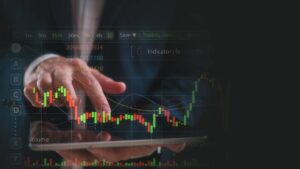Common mistakes in trading, and how to boost your ‘trading in finance’ skills and knowledge

Aussies are increasingly looking for financial advice online. Picure Getty
- Aussies are increasingly looking for financial advice online
- City Index lists mistakes to avoid for novice traders
- Stockhead reached out to IG’s APAC and Africa CEO, Kevin Algeo, for some tips
In the past week, searches on Google for ‘trading in finance’‘ increased by 90% in Australia.
With TikTok’s “FinTok” or “MoneyTok” financial education videos amassing over 23 billion views, it seems that Aussies are indeed searching for financial advice online.
IG, a global online trading platform, has also observed a 67% climb in user engagement of their online education hub IG Academy in Australia.
The number of new users on this hub almost tripled in the last year (by 191%), suggesting Aussie investors’ keen interest in learning and upskilling their trading skills and knowledge.
So with the surge in interest towards trading, experts say that it’s more important than ever to do your own research.
To help those learning about trading, broker City Index has provided a list of what not to do, the most common mistakes and how to steer clear of them.
City Index’s list of most common mistakes
Not developing a plan
Trading without a plan is like navigating unknown waters without a map. It can lead to impulsive and inconsistent decision-making.
Example: A novice trader jumps into the forex market based on a hot tip but doesn’t have a strategy for when, or how much, to buy and sell.
“Putting together a comprehensive trading plan that outlines goals, risk tolerance and methodology can provide a roadmap for consistent decision-making and helps avoid impulsive trading,” says City Index.
Cutting winners short and letting losers run
This mistake is often the product of a desire to secure gains and avoid losses.
Example: A trader buys a promising tech stock. When it rises a bit, they sell out of fear of losing these small gains. Conversely, they hold onto a dropping stock for too long, hoping for a recovery.
According to City Index, the potential solution is:
Establish a clear exit strategy in advance. Using stop-loss and take-profit orders can automate this process, ensuring you’re not cutting profits short or holding losses.
Not setting stops and limits in advance
Not setting stop-loss or take-profit points before placing a trade leaves traders vulnerable to market volatility and potentially significant losses.
Example: A trader enters a gold trade, expecting prices to rise. A sudden fall in prices leads to more significant losses than they were prepared to take.
“Implementing stop-loss and take-profit orders automate risk management. These tools close trades when specific conditions are met, securing profits or limiting losses,” says City Index.
Not understanding the impact of leverage
Leverage allows traders to open positions for just a fraction of the full cost. While this can amplify potential profits, it can equally magnify losses.
Example: A trader uses high leverage to open a large forex position – a slight movement against their prediction results in substantial losses due to the use of leverage.
“Responsible use of leverage is crucial. Understanding the risks associated with leverage, and knowing how much you’re comfortable potentially losing, is a key part of trading strategy,” City Index said.
Trading emotionally
Trading is as much a mental game as it is about numbers and trends. Allowing emotions to dictate trading decisions often leads to high-risk behaviours and inconsistent results.
Example: After a series of successful trades, a trader becomes overconfident and begins to risk more than they can afford to lose.
“Stick to your trading plan and resist the urge to make impulsive decisions based on recent wins or losses,” advised City Index.
Where should you turn to for ‘trading in finance’ education?
Meanwhile, IG’s CEO of APAC and Africa, Kevin Algeo, says that when it comes to managing financial assets, investors should understand more about portfolio optimisation and making the most of a wide range of markets.
This, he says, requires understanding macroeconomics and market correlation, as well as constant upskilling such as understanding risk and reward in investing.
“It is important for beginners to understand the liquidity in their asset portfolio, and what is the best course of action entering the markets,” Algeo told Stockhead.
“Financial literacy education can range from the fundamentals like managing cashflow, through to more complex investing and trading education,” he added.
Apart from reading educational articles on Stockhead, Algeo explains that Aussie investors can access education resources through the very companies which manage their finances – like their banks, home loan providers, super funds and investing platforms.
However, he warns that different organisations provide different levels of sophistication when it comes to educational materials.
“So, Australians should be looking to organisations who can build on their current skills to achieve a balance between confidence and risk management with it comes to their financial decisions,” Algeo said.
He has noticed that Australian investors are good at leveraging online resources, such as YouTube and Twitter.
“It’s important for investors to differentiate credible source of information, usually produced by seasoned analysts with years of market experience, from generic or sometimes misleading advice,” he said.
Algeo says that on IG, one can find resources such as IG Academy, which provides online courses.
The Master Your Mindset Hub is also IG’s guide to help traders develop their trading mindsets to become a better trader.
“The hub is full of practical tips and insights to help traders better understand the psychology of trading – managing risks and trading strategies,” said Algeo.
The views, information, or opinions expressed in the interview in this article are solely those of the interviewee and do not represent the views of Stockhead.
Stockhead has not provided, endorsed or otherwise assumed responsibility for any financial product advice contained in this article.
Related Topics
UNLOCK INSIGHTS
Discover the untold stories of emerging ASX stocks.
Daily news and expert analysis, it's free to subscribe.
By proceeding, you confirm you understand that we handle personal information in accordance with our Privacy Policy.








